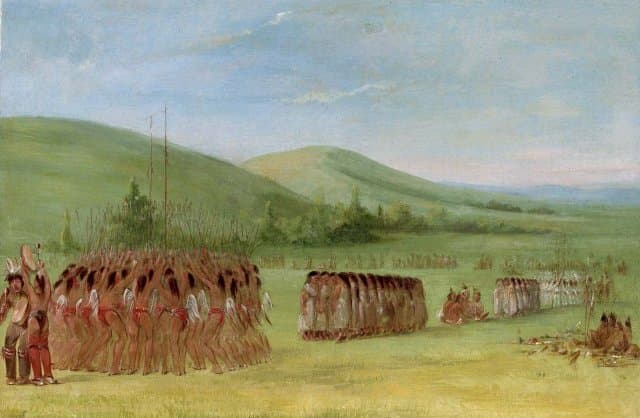Algonquian and Great Lake Tribes
Diet and Agriculture
The Algonquin did some farming but were mainly hunters. They used fish to fertilize their cornfields and tapped maple trees for sap to make sugar. The Algonquin people on the coast had clambakes and ate clams, oysters, lobsters, mussels, and other shellfish. They wrapped fish in seaweed during these clambakes and cooked it in a pit dug in the earth.
The Great Lakes tribes were excellent hunters, farmers, and food gatherers. They ate wild birds and game. The men hunted moose, caribou, beaver, otter, and other small animals. The women gathered nuts, greens, and berries. They grew corn, beans, and squash. One main food was the wild rice growing in the Great Lakes marshlands. They knocked off the grains with sticks, so the rice fell into their canoes.
Cultural Practices

Painting by George Catlin - 1834
Pow Wows
The Algonquins came together every six months for a powwow or general meeting. Each tribe brought its chief to the powwow council. The powwow was an occasion for feasting and dancing. Arguments between groups were settled, alliances formed, and trading completed during the powwow.
Snowsnake
Snowsnake was a game played by the tribes of the Great Lakes. A snowsnake was a long, smooth stick of maple wood. One end was carved to look like a snake’s head. They packed the snow on a long, level strip of ground to play the game. Each player slid the stick along the ground, taking turns. The one who slid the stick the farthest was the winner.
Tools, Weapons, and Utensils
The men made canoes, traps, utensils, and weapons. The Algonquian people used spears to help them catch fish and eels from the bow of a canoe. The women wove fishnets, mats, and bark containers. The Algonquian tribes of Maine and Nova Scotia made birchbark boxes.
Wampum
Hiawatha found a method for the Algonquian people to help them remember messages. Shell beads were woven into designs, each with a special meaning. The wampum belts were used when council chiefs met to help them remember long speeches. Later, the wampum belts were used as money and were often exchanged as signs of good faith.
Art and Craftsmanship
The artists of the Great Lakes used natural objects as models for their artwork. Flowers, leaves, and stems were stitched onto bags and clothing. The Chippewa designed flowing flowers, while the Winnebago embroidered simpler symmetrical floral patterns.
Birch bark
In the northeastern Woodland area, the Native Americans used birch bark to make many items. The outer bark, which was white and paper-like, was used for building canoes and for the outer covering of wigwams. Decorative items such as fans and beadwork were also made from birch bark. Hunting and fishing gear, such as arm guards and quivers, were made from birch bark. Another use was bark containers, which were used to collect, store, cook, and even serve food or other products.
The Native Americans gathered bark from fallen trees all year, but they gathered bark from live trees in the spring when it was thickest and easiest to peel. Pieces of bark were laced together using basswood or dogbane cord, thin strips of inner cedar bark, or black spruce roots. When making containers, handles were constructed with willow or other branches.

This is a student-made dreamcatcher with beads and feathers.
Dreamcatchers
The Algonquian people hung dreamcatchers from cradleboards to protect their babies. They believed the dreamcatcher would catch bad dreams and allow good ones to pass through the web.

This is a student-made medicine bag with beadwork and stitching.
Medicine Bags
Flowers, leaves, and stems were stitched onto bags and clothing. These designs were more than just decorations; they often held spiritual significance and were used in ceremonies. The Algonquians also used these decorated bags to hold medicine or other sacred items.
Tools, Weapons, and Utensils

This is a student-made quiver with painted vines and arrows.
The men made canoes, traps, utensils, and weapons. The Algonquian people used spears to help them catch fish and eels from the bow of a canoe. The women wove fishnets, mats, and bark containers. The Algonquian tribes of Maine and Nova Scotia made birchbark boxes.